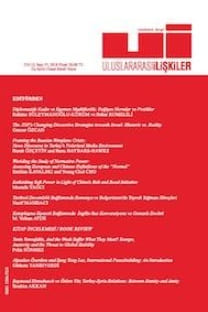Westphalia'dan Günümüze Savaş
Bu makale, Westphalia'dan günümüze savaşın uluslararası sistem düzeyinde dinamiklerine ilişkin analitik bir tartışma sunmayı amaçlamaktadır. Bu bağlamda savaşın geçirdiği evrim, Westphalia-İkinci Dünya Savaşı arası dönem, Soğuk Savaş dönemi ve Soğuk Savaş sonrası dönem olmak üzere üç ana dönem temelinde irdelenmektedir. Westphalia'dan Soğuk Savaş'a kadar olan dönemde, değişik örneklere dayanarak, savaşın daha ziyade güç dengesi politikaları çerçevesinde açıklanabileceği belirtilmiştir. Soğuk Savaş döneminde iki kutuplu bir uluslararası sistemin egemen olduğu ve bu dönemin, “çevre” ülkelerdeki çatışmalar dışında, temelde bir barış dönemi olduğuna değinilmiştir. Soğuk Savaş sonrası dönemde ise savaşın karakterinin değiştiği, devletler arası çatışmalar belirgin bir biçimde azalırken, etnik çatışmalar, terörizm, insan hakları ihlalleri ve daralan kaynaklar üzerine kızışan ekonomik rekabet gibi sorunların barışın asli tehdit kaynaklarını oluşturmaya başladığı vurgulanmıştır.
Anahtar Kelimeler:
Savaş, Uluslararası Sistem, Soğuk Savaş, Soğuk Savaş Sonrası Dönem
War From Westphalia to the Present
This article aims to provide an analytical discussion on the dynamics of war at the international system level, focusing on the period between the Treaty of Westphalia and the present. In this regard, the evolution of war is examined based on three main periods: The period from Westphalia to the Cold War, the Cold War period and the post-Cold War period. It is argued that from the Treaty of Westphalia to the Cold War, war can be explained and understood within a balance of power politics. The Cold War period is identified with the bipolar system, and not counting small wars, it is mainly a period of peace. The post-Cold War period, on the other hand, is seen to have changed the character of war, highlighting ethno-political conflicts, terrorism, human lights violations and severe economic competition for decreasing resources as major threats to peace, while inter-state wars drastically declined in the same period.
Keywords:
War, International System, Cold War, Post-Cold War Era,
- ISSN: 1304-7310
- Başlangıç: 2004
- Yayıncı: Uluslararası İlişkiler Konseyi Derneği İktisadi İşletmesi
Sayıdaki Diğer Makaleler
Terör ve Devlet Terörizmi Çağında Savaş ve Barış
Irak Savaşı bir 'Saldırı Suçu' mudur? İngiltere Lordlar Kamarası'nın bir Kararı
Asimetrik Saldırı Savaşları, Siyaset ve Uluslararası Hukuk
Rousseau'nun Savaş ve Barış Kuramı: Adalet Olarak Barış
